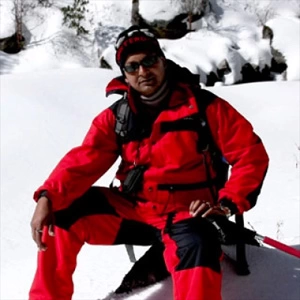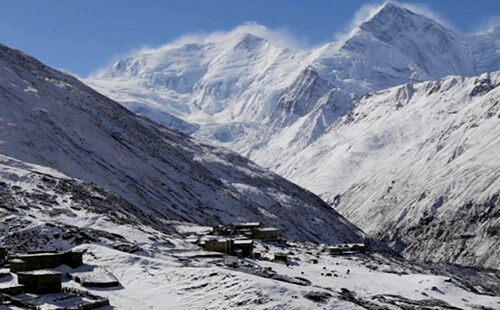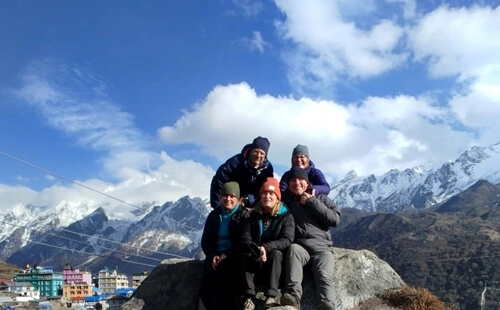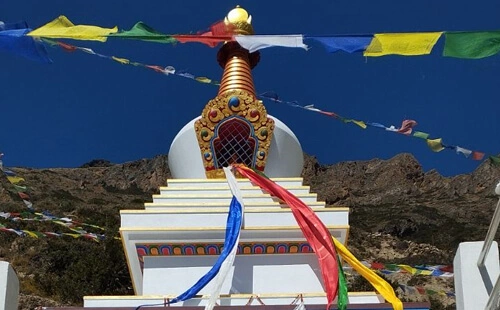Where does the Manaslu Trek take you?
A trek to Manaslu is to explore the serene natural and cultural charm in and around the majestic eighth-highest mountain on earth, Mount Manaslu (8,163m). In this trek, you will not only get to relish the stunning mountain views but also delve deep into the rich cultural heritages that hold a significant spiritual importance, with a slight resemblance to Tibet and Tibetan Buddhism. Although this varies a lot with the individual's walking pace, fitness level, or choice of route, usually commencing with a drive to Soti Khola/Maccha Khola or Arughat, it normally takes about 14 to 18 days to complete the Manaslu Circuit Trek. In west-central Nepal, the Manaslu Trekking Region lies 160 km/99 miles northwest of Kathmandu; hence, this is difficult to access and, in turn, increases the Manaslu Trekking Difficulty. Here are some other elements that increase the Manaslu Trek Difficulty:
Is the Manaslu Circuit Trekking lengthier?
Yes, the total length of the Manaslu Circuit Trek, the classic Himalayan trail among several trekking routes under the Manaslu Conservation Area, varies noticeably based on the trek's starting and ending points. Generally, trekkers begin and end foot walking from Arughat or Soti Khola to Dharapani or Besi Sahar, covering 177 to 200 kilometers on a round trip, and hence it is taken as one of the lengthier and more challenging trekking destinations in Nepal that circumnavigates Mount Manaslu and also includes crossing the high-altitude Larke Pass (5,106m). Even if you are not traversing the circuit, the Manaslu Trekking can typically span from two weeks to more. Therefore, you must make up your mind about long walking days and altitude gain swiftly, major elements that determine the Manaslu Region Trek Difficulty for you.
Manaslu Trek altitude: How high will you reach during the trek?
While the highest point of this high-altitude trekking in Nepal in the Manaslu Trekking Region may vary on the specific route you have chosen to move forth on, the gain in altitude is often rapid. Starting at around 700m, if you are traversing into the Manaslu Circuit Trek to encircle the 8th highest mountain giant in the world, Mount Manaslu (8,163m), you will cross one of the highest and longest mountain passes called Larkya La at an elevation of 5,106m. Even if you are not, trekkers are expected to walk several days, 3,000m above sea level, in Himalayan regions where the level of oxygen decreases with the increase in altitude, followed by high chances of altitude sickness, also called acute mountain sickness (AMS), which can get fatal if not taken care of in time. Hence, proper physical conditioning and acclimatization become crucial to make sure you are prepared for the best as well as the worst-case scenarios that are inherent to the high-altitude trekking in Nepal.
What are the Manaslu Trekking Challenges in Nepal?
Overall, the Manaslu Trekking Grade, including for 2025 and 2026, can be taken as a moderately challenging to strenuous high-altitude Himalayan journey in Nepal, the country known for its majestic hills and mountains, demanding a good level of physical fitness, mental resilience, and thorough acclimatization to high altitudes irrespective of your final choice of routes from several others. Here are some of the major factors that determine the Manaslu Trek Difficulty Level, which can also be taken as a Manaslu Circuit Trek Guide, even if you are looking forward to embarking on the Manaslu Trek without a guide.
Where are the most physically challenging parts of the Manaslu Trek?
During the Manaslu Trekking in Nepal, trekkers walk through the well-trodden trail; however, after a certain period of hiking, it may get rocky and uneven, including steep ascents and descents. With the rise in altitude as the trekking days pass, daily hikes of 5-7 hours can lead to fatigue, especially around Larkya La Pass during the Manaslu Circuit Trek, where it becomes difficult to breathe due to thin air, freezing temperatures, and strong winds. Other than the rugged nature specifically around the pass, the terrain can be icy or snowy.
Breaking down the Manaslu Circuit Trekking Trail alone, the ascent to Samdo from Dharamsala has a high risk of altitude sickness due to the increasing elevation in a short time frame. The treks to Deng, Namrung, and Lho are longer and can test your endurance and leg strength, followed by landslide-prone areas, river crossings, and narrow cliffside paths between Jagat and Deng. To conclude, the Manaslu Trekking Trails, though not technically challenging, are more rugged and remote than some of the more commercial treks in Nepal, like the Everest Base Camp Trek, the Annapurna Base Camp Trek, and the Langtang Valley Trekking routes.
How long is each Manaslu Trekking day, and how does that affect the level of difficulty?
The Manaslu Trek in general involves 5 to 7 hours daily, sometimes more on longer sections of the trail, depending upon altitude and individual pace. Early trekking days at lower elevations featuring gentle paths along river valleys, though, can be longer but are less strenuous, while higher-altitude days leading up to and from Larkya La Pass after Samagona can be shorter but significantly more physically demanding. The multiple days of trekking precisely through the steep ascents and descents over rocky trails and moraines tend to cause tiredness if you are not well-prepared.
That is why maintaining good fitness and gathering some high-altitude experience are always wise things to do before officially departing for the Manaslu Trek, including in the years 2025 and 2026, as walking several days in such remoteness is not everyone’s cup of tea.
When is the best time to trek Manaslu to minimize difficulty due to weather?
The weather is, above all, when you are embarking on a Himalayan trail, whether it's in Nepal or any other Himalayan nation, if your purpose of visit is trekking, hiking, or climbing, including the Manaslu Trek. The unpredictability, the ability to get snowy, rainy, or sunny in the blink of an eye, makes it one of the major factors that determine the Manaslu Region Trek's difficulty. Hence, you must choose an ideal time of the year, where the spring season from March to May and the autumn season from late September to December stand out for stability, followed by crystal clear skies, excellent visibility, and moderate temperatures.
While most of the trekking routes to Manaslu are through the trans-Himalayan region in the rain shadow area, making it just the perfect monsoon alternative trek destination, in the lower elevation, the chances of encountering slippery and muddy trails followed by active leeches are high, proportionally contributing to the Manaslu Trekking Difficulty. Similarly, winter, from December to February, means chances of heavy snow dumping and avalanches near the pass or blocking of trails if not on the Manaslu Circuit Hiking Route, along with colder nights that can go below freezing points altogether, making the trek more difficult and requiring extra seasonal layers and preparation.
Who should consider avoiding the Manaslu Trek and why?
Almost all of the Manaslu Treks are doable, including the Manaslu Circuit, even for beginners if prepared well with at least a month of physical conditioning, appropriate packing, and the assistance of experts in the field, like Adventure Himalayan Travels and Treks. However, if you are someone who does not enjoy long trekking and is not ready for remoteness, substantially increasing the Manaslu Trekking Grade, you may want to begin with well-established and easily accessible treks to the Everest and Annapurna regions. The teahouses are basic and comparatively lower in number, offering limited amenities on a shared basis. The heating facilities are privileged with the increased altitude to expect booking accommodations in advance, especially during peak trekking seasons in Nepal: spring and autumn.
Food options, communication, and medical facilities alike are limited. At some point, internet connectivity can get unreliable and out of range, making it difficult to maintain contact, charge your electronic devices, and get immediate medical professional help in needed. To conclude, the Manaslu Trekking Region has its unspoiled cultural and natural charms that, with some certain challenges, are rewarding and worth it for those who consume knowledge of high-altitude trekking conditions whose primary goal is a genuine connection to mountains, nature, and Himalayan culture, far away from rapid urbanization that perhaps is one of the leading causes of distress mankind is suffering from every day.
When do the permit requirements become a challenge during trip planning?
Due to the Manaslu Trekking Region being under one of the highly restricted areas of Nepal, considering the cultural, ecological, and border sensitivity near Tibet, it requires a specific additional permit called a Restricted Area Permit (RAP), which can add a layer of complexity to the planning process, adding much to the Trek to Manaslu Difficulty. Unlike obtaining other essential trekking permits in Nepal, it is a must that you are in a group of at least two trekkers, excluding a professional local guide from a licensed trekking agency like Adventure Himalayan Travels and Treks. Also, answering your query, Manaslu Trek without a guide is not legally permitted, making the Manaslu Trekking Difficulty beyond the physical challenges of the trail.
Much to the delight of trekkers booking a Manaslu trip with us, we take care of all the necessary trekking logistics, including obtaining permits; therefore, hiring guides and porters is a must to make the trek more accessible and less complicated.
Is the Manaslu Trek for beginners?
Well, if you are a first-timer setting off for high-altitude Himalayan trekking with some prior multi-day hiking experience, the Manaslu Trek can be feasible for you. If you are someone in good shape, engaged in regular exercise, possessing high altitude awareness, followed by comfort with significant altitude gain, and used to hiking uphill with a backpack for several hours, a trek to Manaslu can be suitable for such kinds of beginners. This high-altitude trekking Nepal to the Manaslu region rewards you with an unparalleled experience, whether you are a novice or a seasoned trekker, if you are both physically and mentally prepared for the remote yet scenic trail and are willing to hire a guide and be part of a group. Or, you may begin preparing right now with cardio exercise, strength training, and practice in local hiking routes!
Manaslu Trek with Guide Vs Manaslu Trek without Guide: Can you go solo?
No, solo trekking inside the Manaslu Conservation Area is not permitted, along with several other national parks, conservation areas, and restricted premises in Nepal since April 1st, 2023. So, if you were planning the Manaslu Circuit Trek without Guide, you may want to make changes and prefer the Manaslu Circuit Trek Guide. Though it is mainly due to the restricted area status of the Manaslu Conservation Area, hiring guides is for wise navigational and logistical support on remote trails, besides obtaining essential trek permits. Local guides, including those from Adventure Himalayan Travels and Treks, provide you with cultural insights and language translation, bridging both the cultural and language barriers for you.
In addition, guides and porters are there for emergency response and first aid, so while you can not trek alone, you can trek in a group of two with a guide and porter, which is not only affordable but also a safer trekking experience.
Conclusion
The Manaslu Trek, such as the Manaslu Circuit Trek, Tsum Valley Hike, Nar Phu Valley Trip, or combined Tsum Valley Manaslu Trekking Trail and Manaslu with Annapurna Circuit Trek of 23 days, is undoubtedly challenging; it is extremely rewarding as well. These are the result of altitude, length, plus regional difficulty, and while not recommended for beginners, if you are determined and have immersed yourself in physical and mental conditioning essential for high-altitude treks in Nepal, Manaslu Trekking in 2025 and 2026 is happening.
For those seeking solitude, untouched trails with immense cultural heritages, and awe-inspiring Himalayan scenery, with proper preparation, a reliable guide, and acclimatization, trekkers can enjoy the beauty and cultural richness of the Himalayas to the fullest! Book with us now and be at ease knowing you are in the right hands with more than two decades of experience!




